Historical location
Zugarramurdi is a small village located in the Foral Community of Navarra, in northern Spain, near the border with France. This place is famous for its association with witches and witchcraft, especially due to the events that occurred in the early 17th century.
Zugarramurdi’s connection to witches dates back to 1610 when one of the most famous and tragic witchcraft trials in the history of Spain took place. This trial was led by the Inquisition tribunal of Logroño, which accused numerous people from the village and its surroundings of practicing witchcraft. According to records, around 40 people were accused, and many of them were tried and sentenced to the maximum penalty: the stake.
The case of the witches of Zugarramurdi was largely based on testimonies and confessions obtained under torture, where the accused supposedly admitted to participating in sabbaths and other rites considered heretical by the Inquisition. It was said that these gatherings took place in the Witch’s Cave, also known as Zugarramurdi Cave, a place that has now become a tourist and cultural attraction.
The cave, located on the outskirts of the village, is a large karstic tunnel formed by the action of the Olabidea stream. It is famous for being the setting where supposedly the witches of Zugarramurdi celebrated their sabbaths. Nowadays, the cave and the Witch Museum in the village offer visitors the opportunity to learn more about the history of witchcraft in the region and the events that led to the tragic witch hunt.
The case of Zugarramurdi serves as a reminder of the collective hysteria and persecution that many people accused of witchcraft suffered in Europe during the Early Modern period. The story of the witches of Zugarramurdi has transcended time and become part of folklore and popular culture, inspiring books, movies, and festivals that commemorate the memory of the people affected by these events.
African art in the avant-garde of the 20th century
Matisse and Picasso find themselves in Matisse’s brightly lit studio, surrounded by vibrant canvases and sketches of dancing figures. Sunlight filters through the large windows, enhancing the colors and shapes that speak of both artists’ shared interest in dance and African art.
Henri, looking at a canvas he has been working on, says, «Pablo, I have always been captivated by the purity and simplicity of African art. Its influence on my work, especially in how I approach the human figure, is undeniable. Look at this piece; I tried to capture the essence of dance, that feeling of movement and freedom, inspired by African sculptures.»
Pablo, with a thoughtful look, responds, «Henri, I understand exactly what you mean. African art has a strength, a vitality that is missing in Western tradition. When I first saw those African masks, it was like a revelation. They freed me from conventions; they taught me to see beyond the physical form, to explore the spirit, the emotion behind the figure.»
Matisse: Exactly, it’s that exploration of the spirit that fascinates me. In dance, as in African art, there is a direct, unadorned communication with the essence of human experience. I try to make my painting speak that same language, to communicate directly with the viewer, evoking deep emotions.»
Picasso: Dance, with its rhythm, its energy, its ability to express complexity in a simple way, parallels what we both seek in our painting. African art has taught us to value abstraction, to appreciate the power of simplified forms to convey deeper emotions and states of being.
Matisse: It’s a constant search, isn’t it? In every brushstroke, in every line, we seek that connection, that dialogue between our works and those ancestral principles. It’s a challenge, but it’s also what makes art so rewarding.
Picasso: Nodding, adds, «And that challenge keeps us moving forward, experimenting, learning. African art has not only influenced our work; it has expanded our understanding of what art can be, of how it can connect with the deepest parts of the human being.»
My artistic review
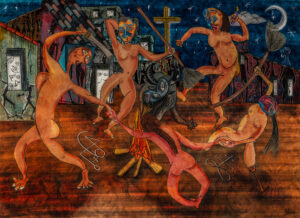
As the conversation flows, both artists reflect on their art, their passion for dance, and how African art has enriched their vision. Through their dialogue, it becomes clear that, for Matisse and Picasso, the influence of African art and dance is not just a matter of aesthetics, but a deep connection to the essence of human experience, a bridge to new forms of expression and understanding in art.
In this piece, I have delved into the depths of legend and history, intertwining the dark narrative of Zugarramurdi with the visual language of a late conversation between two icons of the 20th-century avant-garde. I have attempted to reflect ecstasy and horror, blending the fluid expression of Matisse’s dance with the Picassian iconography that decomposes reality into multiple facets.
Upon contemplating this work, you will observe figures that seem to move to the rhythm of an ancient ritual, their bodies twisted and distorted in shapes that defy logic and proportion. Here is the witches’ sabbath, not just a gathering of witches but a dance of intertwined stories and destinies, marked by symbols that allude to both ancient wisdom and inquisitorial persecution.
At the center, the demonic figure of the Master of Ceremonies, the personification of the fears and misunderstandings that led to the tragedy of Zugarramurdi. The witches dancing around him are not just figures of fear but also of resistance and a power that cannot be contained even by the flames of the bonfire.
This canvas is my tribute to the souls of Zugarramurdi, a reminder that beauty and tragedy can coexist, intertwined in an eternal dance. I have sought to capture not only the movement but also the emotion, the rhythm of the story that beats beneath the surface of the painting.
The Sketches
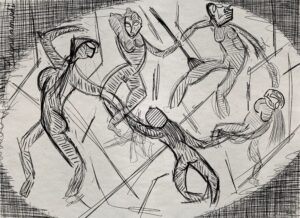
This sketch captures the initial essence of Zugarramurdi’s work, showing dynamic and stylized figures in a whirlwind of expressive lines. With energetic strokes, the artist sketches a wild dance that evokes movement and ancient rituals, setting the stage for a fascinating visual narrative of myth and history.
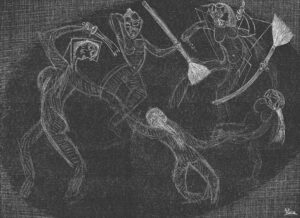
In this sketch for «Zugarramurdi,» ethereal figures etched in white dance across a dark canvas, evoking a ghostly nocturne. Their forms are fluid yet haunting, each stroke revealing an otherworldly gathering steeped in the lore of witchcraft and mystery.
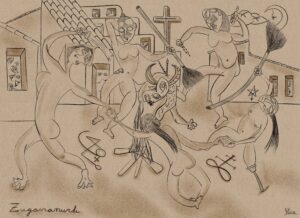
This final sketch of «Zugarramurdi» portrays a bewitching dance of figures, intertwining pagan and religious symbols within a sepia-toned vortex, capturing the essence of the famed witch trials in a hauntingly surreal narrative.
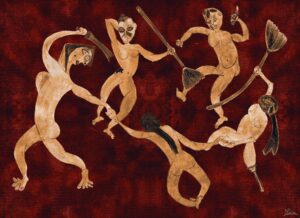
The color test of «Zugarramurdi» showcases figures in a bewitching dance, their nude forms contrasting against the rich crimson backdrop, highlighting the dynamic movement and primal essence of the ritualistic dance central to the piece.
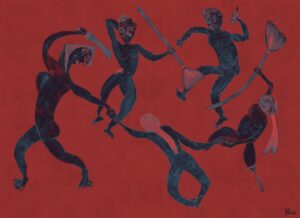
This color test of «Zugarramurdi» spotlights a tribal-inspired dance, with figures in shades of blue against a fiery red background, emphasizing a primal, rhythmic movement that echoes ancient rites and ceremonies.
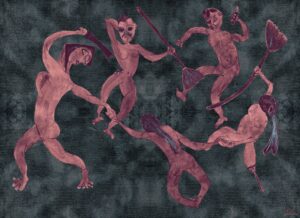
The dance of Zugarramurdi takes on a mystical air in this color test, where the silhouetted figures perform their ritual against a dusky backdrop, their reddish tones glowing eerily, as if lit by the embers of an unseen fire.
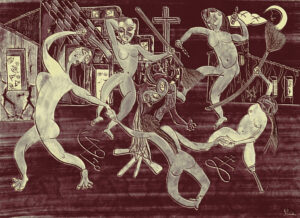
This color test of «Zugarramurdi» emphasizes the witch’s sabbath, with spectral figures engaging in a macabre dance around a demonic presence, all set against an ominous backdrop that accentuates the scene’s arcane and secretive atmosphere.
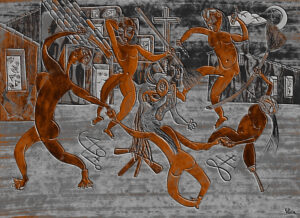
The witch’s sabbath of Zugarramurdi is depicted with a fiery palette in this color test, where the dancers, awash in sepia and copper tones, circle a central demonic figure against a backdrop of shadowy hues, evoking an air of mystery and ancient ritual.
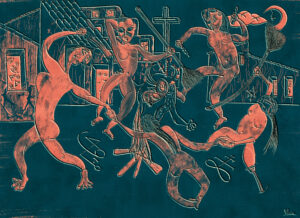
This color test of «Zugarramurdi» portrays an unearthly sabbath where silhouetted figures, highlighted with a fiery copper tone, perform a ritual dance around an otherworldly creature, all set against a teal canvas that imbues the scene with a supernatural chill.
Technical characteristics of the work
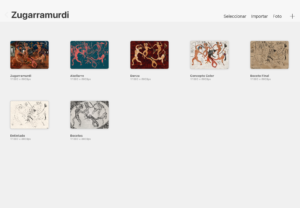
Zugarramurdi’s work is a piece of digital art created using Procreate software, known for its powerful drawing and painting interface intended for professional artists. The resolution of the file is extraordinarily high, 11000×8000 pixels with a density of 300 pixels per inch (ppi), suggesting an extremely fine level of detail and the possibility of making large prints without losing image quality.
The execution time, around 30 days, and the need to divide the work into 7 different files, reflect the complexity and scale of the project. This piecemeal approach is a strategy to better manage device resources or to organize work into defined stages, such as sketches, color tests, and final details.
The combination of technology and dedication of time indicates that this work is the result of an intensive and carefully planned artistic process, allowing the vibrant and mystical essence of Zugarramurdi to be captured with a wealth of detail and color.
Other resources of the work:
Link to YouTube video focused on giving context to the work through its sketches.
Link to YouTube video focused on the final result of the work along with its creative process.
Link to collection on OpulenceX NFT Market
The sale of the collection on the OpulenceX NFT market on the XRP blockchain, betting on a cutting-edge solution in art distribution.
This form of marketing also allows potential buyers to invest in digital art with the possibility of its value increasing over time, while guaranteeing the exclusivity and authenticity of their purchase thanks to the unique nature of NFTs. By dividing the collection into three thematic groups—Sketches, Dance, and Coven—you offer variety and allow different tastes and budgets to find something of interest. Each piece, when tokenized as an NFT, will carry with it a 30-day creation history and the artist’s digital signature, adding even more value to each work.
The Original Work is valued at 2000 XRP, which underlines its exclusivity and artistic value. The remaining pieces are priced at 200 XRP, making the collection accessible to a wider range of digital art collectors.
The OpulenceX NFT XRP Marketplace provides a platform for secure and transparent transactions using the XRP cryptocurrency. This sales method takes advantage of blockchain technology to ensure the authenticity and ownership of works, which is essential in the digital art market. Each NFT guarantees the buyer exclusive ownership and rights to the purchased piece, making each purchase an investment in a unique and verifiable item.
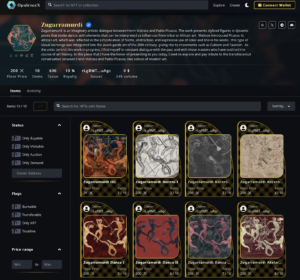
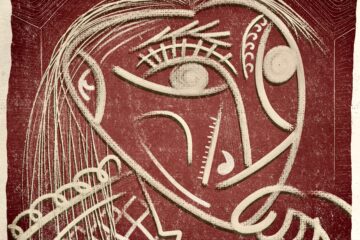


0 comentarios